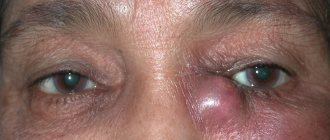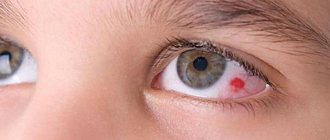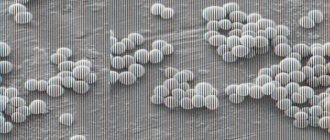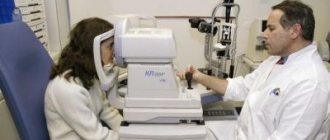Symptoms of stye on the eye
The fact that barley has appeared on the eye is indicated by a small round formation on the eyelid, inside of which there is purulent content. In the first 3 days after infection occurs, the following symptoms are observed:
- hyperemia of the eyelid;
- itching, burning;
- swelling.
If treatment is not started immediately, the stye will continue to proliferate, resulting in the formation of a purulent abscess. Depending on the location of the inflammatory process, hordeolum is of two types:
- Outer. A stye appears due to damage to the hair follicle of the ciliary edge; an abscess with a white-yellow head forms on the outer side of the eyelid. Touching the formation is accompanied by pain.
- Interior. The meibomian gland becomes inflamed, styes appear on the inside of the eyelid. A rounded lump is noticeable when the eyelid is pulled to the side. The skin around the eye becomes inflamed and swollen.
As the puss gets larger, the symptoms intensify, and the following unpleasant phenomena occur:
- tearfulness;
- soreness;
- increased sensitivity to light;
- sensation of a foreign body in the eye.
A week after the barley pops up, the abscess breaks through, the symptoms subside and completely disappear. After this, regeneration of the skin occurs. In the first stages of development, in addition to the main manifestations of the pathology, nonspecific symptoms such as headaches, hyperthermia, chills and lymphadenitis may be observed.
Symptoms of stye in adults and children
An abscess may appear within a few hours after an infection has entered the eyelid area. A purulent process and pain arise very quickly - the anomaly occurs in the acute stage, in fact, from the very first days.
Typical symptoms:
- edema, swelling of the conjunctiva, severe redness;
- pain, itching and burning in the affected area;
- The outer, fibrous membrane of the eye also turns red due to inflammation;
- Along with these signs, enlargement of the lymph nodes located next to the ears may be observed, the temperature rises, headaches, attacks of nausea occur, and the patient develops other signs of poisoning of the body.
A purulent ball can develop on the upper or lower eyelid; sometimes there are 2-3 of them in one eye. The tumor opens after a couple of days and then the pus flows out, but it happens that the formation resolves without breaking through.
The patient experiences lacrimation as the eyelash hairs are displaced due to the tumor. The person feels weak, chills, and loses appetite. In some cases, the tumor is so extensive that it completely covers the eyeball.
How to quickly treat stye on the eye at home if this happens? There are some methods, but you cannot treat this disease on your own, much less open the abscess - it is wiser to contact a specialist who will tell you what to do.
Barley can be external and deep, located on the inside of the eyelid. An ordinary abscess (hot) goes away within 6-7 days, but there is also a cold stye that lasts about two months. When it begins to interfere with visual function, because it puts pressure on the eye, it has to be removed surgically.
Symptoms of the disease
The appearance of a puss is impossible not to detect even in the initial stages; they cause a lot of inconvenience.
- Redness and swelling. The degree of swelling depends on the size of the affected area and the individual characteristics of the disease. Sometimes the eye may close completely, limiting the angle of vision.
- Itching of varying intensity, painful sensations on palpation. The itching can be very severe, which provokes mechanical damage to the inflamed area on the eyelid.
- The appearance of one or more pimples of varying sizes. After 2-3 days, pus and dead tissue are released from them. The abscess can open on its own; in some cases, the boil moves into the tissue and turns into a solid tumor.
- Intoxication of the body. Occurs after attempts to independently remove pus by squeezing. The infection enters the bloodstream and can cause dangerous consequences. A headache appears and the body temperature rises sharply. This patient’s condition requires immediate medical intervention.
Internal and external styes
In any case, after the appearance of a pus, it is recommended to go to a medical institution; only a doctor can determine the real cause of the disease and develop an optimal drug treatment plan.
Symptoms of stye
Symptoms of stye (signs of stye) are very easy to determine both visually and tactilely. This:
- limited swelling, dense and painful to the touch;
- swelling of the surrounding tissue;
- redness and swelling of the conjunctiva (the mucous membrane of the eye);
- nonspecific symptoms of acute inflammation are possible: fever, chills, enlarged lymph glands, headache, etc.
Internal styes have similar symptoms.
As barley ripens, it turns yellow and becomes denser and more shaped. A white dot appears at its top. After 3–4 days from the onset of the disease, the abscess opens and its contents are released.
More severe forms of the disease are also possible - with the development of an abscess and subsequent scar formation. In rare cases, the process may be complicated by the involvement of other tissues of the eye and head in purulent inflammation.
Causes
Many people mistakenly believe that stye in an adult or child is a consequence of hypothermia. But this is absolutely not true; hypothermia is just a provoking factor. Because of this, immunity decreases and a person becomes susceptible to various infections.
The cause of an abscess under the eye can also be the following negative factors:
- hidden infection in the body;
- gland blockage;
- respiratory diseases;
- weakened immune system;
- failure to comply with basic hygiene. Using someone else's towel, glasses or bed linen;
- hypothermia or lack of vitamins in the body;
- chronic diseases of the digestive tract;
- demodicosis and blepharitis;
- furunculosis;
- helminthic infestations.
Stye under the eye is often observed in pregnant women and young children. This is explained by the greatly reduced immunity of patients in these categories.
Treatment of barley with folk remedies
Before treating stye on the eyelid, you need to determine at what stage the inflammatory process is. The choice of treatment method depends on the stage of development of the disease. At the very beginning of the appearance of stye, when there is slight tingling, slight redness and discomfort in the eyelid area, you can cure stye quickly at home, even within a day, using two main methods:
- Cauterizing the eyelid with an antiseptic;
- Warming up with dry heat.
Treatment of external styes on the eyelid
To cauterize barley you will need a cotton swab or a small cotton wool pad, and an antiseptic of your choice:
- Camphor alcohol;
- Zelenka;
- Medical alcohol diluted with water (1:1);
- Iodine.
A cotton swab is moistened in an antiseptic solution, after which the affected area is cauterized for a few seconds. This procedure can be carried out several times a day. The main condition is that cauterization should be carried out with the eyelid closed to avoid the antiseptic getting into the eye.
You can try to cauterize the ripening barley with a clove of garlic, which has a strong antiseptic effect. It is enough to cut a clove of garlic in half and apply it to the source of inflammation. But this method is unsafe, because... may burn the skin on the eyelid.
Warming up the eyelid can be done in several ways:
- A hard-boiled egg is wrapped in clean cotton cloth and applied to the site of inflammation for 4-6 minutes.
- The salt is heated in a frying pan and placed in a small bag (or a regular sock).
- Place hot boiled potatoes in a thick cloth and attach to the barley.
- Pour boiling water over the bay leaf and leave for ten minutes. Remove the leaf from the boiling water and apply it to the sore eyelid until it cools, and then take the next leaf and repeat the procedure.
- Cut the onion into rings and place in a frying pan with vegetable oil. As soon as the onion is warm, place it on a cotton cloth and apply it to the sore spot.
Warming is carried out until the compress cools down.
Treatment of internal stye under the eyelid
Internal styes on the eye can also be treated with heating, but manipulations will need to be carried out for a longer time, and instead of cauterization, lotions and compresses are used.
How to treat stye on the lower or upper eyelid using lotions, folk remedies and recipes:
- Tea brew from barley. To quickly cure barley, make a strong infusion of tea, this is an old folk method of therapy. It can be used simply to wash the eye, or dip a cotton infusion into the drink and apply it as a lotion to the sore eye. Keep compresses with tea on the eye for about 15-20 minutes, the procedure is repeated 4-5 times a day.
- Chamomile for lotions. Chamomile has anti-inflammatory and healing properties in non-traditional medicine. Pour boiling water over two teaspoons of dry herb and let it brew for a while. Apply lotions to the affected eye 3-5 times a day for 7-10 minutes.
- Aloe juice for eye styes. Aloe leaves have a stretching and anti-inflammatory effect in many human diseases. Cut a small aloe leaf into small pieces and squeeze the juice out of them. Mix aloe juice with clean boiled water and let it brew for about 8 hours. Apply a cotton pad soaked in the infusion to the barley 3-4 times a day.
- Dill to relieve inflammation. Dill seeds help relieve swelling and eliminate redness in the inflamed area. Grind a couple of tablespoons of dill seeds in a mortar and add cold water (2 cups). Bring the mixture to a boil over low heat, and then cool. Using the infusion, you can wash the sore eye or make compresses based on it.
- Calendula is also used to relieve inflammation. Prepare an infusion of calendula according to a popular recipe: pour a glass of boiling water into a tablespoon of inflorescences and infuse for half an hour. Cotton pads soaked in calendula infusion are applied to the sore eyelid.
If barley appears on the lower eyelid, then the entire eye area needs to be treated so that the infection does not spread further. On the upper eyelid, procedures should be performed with the eye closed so as not to damage the mucous membrane of the eye.
Treatment with folk remedies and methods can be carried out in combination. For example, after washing the eyelid or applying a lotion, you should carry out the procedure of warming up or cauterizing the stye. This will help cure stye quickly in just a few days.
If an abscess appears, you should stop all home treatments and turn to medications for the treatment of stye, having first consulted an ophthalmologist.
Treatment of stye on the eyelid
Standard local effects include: cauterization (alcohol, iodine, brilliant green); ointments (tetracycline, chloramphenicol, yellow mercury, etc.) and drops (albucid, etc.). Often excellent results (accelerate the ripening of barley, cleanse the wound and heal) are brought by traditional methods - washing and lotions from strong tea, herbal infusions (calendula, chamomile, plantain, string, eucalyptus, sage), compresses from peeled boiled eggs, fresh or boiled garlic , a dry bag of flax seeds, gauze moistened with aloe juice, propolis tincture, laundry soap with powdered sugar, etc.
Very often, in folk recipes for the treatment of barley, saliva is also mentioned. It is advised to start using it immediately when the first signs appear, simply lubricating the sore spot. The use of “hungry” saliva is considered especially effective.
Under no circumstances should you force the opening of the abscess. This can lead to complications and the appearance of an abscess, as well as to the spread of the purulent process to adjacent tissues of the eye and face.
Who is entitled to pre-retirement benefits?
Before answering the question what privileges, guarantees and benefits are available to citizens of pre-retirement age in Moscow, let’s define who is entitled to them, who “persons of pre-retirement age” are and how this concept appeared.
In order to implement the pension reform in the Russian Federation, on October 3, 2020, the President of the Russian Federation signed a law providing for a gradual increase in the retirement age in the Russian Federation from 55 to 60 for women and from 60 to 65 years for men. It was then that people in Moscow started talking about “citizens of pre-retirement age” and began to discuss guarantees and privileges for pre-retirement people to protect their rights during the reform of the pension system.
In Russia, there are many federal benefits that are “tied” to the status of a pensioner. For the transition period of reforming the pension system in 2019-2028, all these federal benefits are provided to pre-retirees, as if there had been no increase in the retirement age in the Russian Federation. Moreover, in addition to federal benefits, Moscow also has regional privileges and benefits. Read more about pre-retirement guarantees and privileges, what benefits are available to pre-retirement workers and how to apply for pre-retirement benefits in Moscow.
How to recognize barley?
In order to start treating barley on time, it is important to be able to distinguish it from other diseases. To do this you need to know the first symptoms:
- swelling and itching;
- feeling of heaviness;
- visible redness;
- the appearance of a small bump.
In other diseases, swelling is usually not localized, but spreads along the entire length of eyelash growth. However, stye on the eye can be not only external, but also internal, when the abscess is on the inside of the eyelid. It causes more discomfort and pain. Its symptoms are the same as those of the more common variant.
After 3 or 4 days, it will be difficult to confuse the illness with anything else. New symptoms will appear that are almost impossible to hide. So it is advisable not to miss the moment when you can start doing something, then deterioration can be avoided. Such signs may be:
- a tubercle shaped like a grain;
- significant swelling of the eyelid;
- severe redness of both the eyelid and conjunctiva;
- Often more ulcers form nearby.
On the fifth day, a breakthrough occurs, after which pus begins to flow out. If the stye is internal, then there is a risk of eye infection. Sometimes resorption occurs without leakage of pus. After which the swelling quickly goes away, redness persists for some time.
A big red ball on the eyelid will not decorate anyone. But in addition to discomfort and spoiled appearance, the body sometimes reacts with other signs. They are connected by the fact that he has to fight the infection.
These may be the following symptoms:
- headache and dizziness;
- temperature increase;
- enlarged lymph nodes;
- unpleasant tic;
- feeling of weakness.
In some cases, it is difficult to limit yourself to treatment at home. You should consult a doctor if:
- after five days the stye did not begin to go away;
- the abscess presses on the eye, causing severe pain and interfering with vision;
- the stye goes away, but soon appears again on the same or another eye;
- an abscess leads to conjunctivitis.
The doctor, after studying the symptoms, will be able to determine what to do to alleviate the condition. If an abscess has appeared that affects vision, a specialist can open it. Under no circumstances should this procedure be done independently. In addition, the doctor will select medications, if necessary, antibiotics, that will help get rid of the disease.
A long-known way to get rid of stye at the initial stage is to warm the inflamed area of the eyelid with a warm boiled egg.
Frequent barley is a sign of serious illness
What to check for if barley constantly comes out? If stye appears on the eye with enviable regularity, doctors recommend undergoing a full medical examination, since sometimes such a phenomenon indicates the development of the following diseases:
Diabetes
A common disease characterized by increased blood sugar levels. The pathology is manifested by the following symptoms:
- constant thirst;
- dry mouth;
- frequent urination;
- increased appetite;
- weight loss;
- tingling, numbness in the limbs;
- constant fatigue, drowsiness.
Read in a separate article: Treatment of styes on the eye with medications in adults and children: drops and ointments
Hypercholesterolemia
Characterized by an increase in blood levels, manifested by the following symptoms:
- angina pectoris;
- yellow-orange spots on the eyelids;
- xanthomas on the extremities;
- gray arc on the periphery of the ocular cornea.
Seborrhea
A skin disease characterized by disruption of the sebaceous glands. The following signs may be observed:
- peeling of the skin;
- greasy, rough skin;
- deterioration of hair condition;
- dandruff;
- red spots on the skin;
- skin itching.
Rosacea
A chronic skin disease in which rosacea, reminiscent of teenage acne, forms on the face. The pathology is easy to diagnose by the following manifestations:
- redness of the facial skin;
- increased skin sensitivity;
- rashes;
- red spots on the face;
- burning sensation;
- swelling of the face.
Thyroid dysfunction
Thyroid dysfunction can be suspected by the following signs:
- constant fatigue;
- increase in neck volume;
- frequent depression;
- weight disorder;
- dry hair, skin;
- swelling of the face;
- constant feeling of cold.
Blepharitis
An ophthalmological disease characterized by inflammation of the edge of the eyelid. It can be infectious or non-infectious in nature, manifested by the following symptoms:
- hyperemia of the eyelid;
- swelling;
- itching;
- eyelash loss;
- photosensitivity;
- feeling of sand in the eyes;
- tearfulness.
If the above symptoms appear, you must contact an appropriate specialist and undergo a detailed examination. Sometimes frequent barley is a sign of gastrointestinal disease. Therefore, if dyspeptic disorders or other manifestations of digestive disorders are observed, you should consult a gastroenterologist.
Timely detection and elimination of the problem allows you to avoid serious complications.
What is a piss on the eye
A puss on the eye is a stye or an abscess. It can be external, when the purulent head is clearly visible, and internal, when the eyelid is simply well swollen. An abscess on the eyelid occurs as a result of pathogenic microorganisms entering the hair follicle in the eyelash area.
If the pus on the eye is internal, then the swelling persists for a long time. Pus may break into the conjunctival sac, in which case conjunctivitis develops. The external stye can break out on its own, in which case the patient’s condition immediately improves. If the abscess does not break out on its own within several days, then it is opened.
Types of barley
Styes on the eye can be external (the head is visible) and internal, only swelling on the eyelid is visible.
- With external inflammation, the abscess is located on the edge of the eyelid, an abscess forms on the outside of the eyelid. Develops as a result of infection of surrounding tissues.
- If the piss on the eyelid is internal, the head with pus may be absent, but the swelling on the eyelid will persist. The abscess is located on the inside of the eyelid. Occurs due to infection and subsequent inflammation of the meibomian glands. They are located in the middle of the eye at the very base of the cilia. The glands maintain moisture in the eye and prevent tears from evaporating from their surface. In case of clogging of the glands, internal pussy can lead to the development of an inflammatory process of the sebaceous gland.
Why do wrinkles appear around the eyes?
Not every woman can afford the services of plastic surgeons in elite clinics. The lifting procedure in beauty salons costs incredible amounts of money. But it is quite possible to improve the condition of your skin at home.
Even twenty-year-old young ladies can see small wrinkles in the delicate area of the skin around the eyes. Especially if they are characterized by increased emotionality, and, as a result, active facial expressions. Sadness and joy, surprise and delight - all this is fraught with the appearance of “crow’s feet” near the eyes. If you have fine wrinkles or slight swelling under your eyes, you can restore the firmness and elasticity of your skin with homemade masks and special eye exercises.
You can take care of the skin around your eyes with simple home remedies.
Treatment
There are many ways to get rid of the disease. Treatment depends on the affected area, stage of the disease and existing complications. Therefore, treatment must be started immediately after the first symptoms are identified. The best option is complex treatment, which combines a number of measures to restore eye health.
Drops
Eye drops are used to effectively combat harmful bacteria. They are quickly absorbed into the mucous membrane and act almost immediately, blocking the development of the disease.
Levomycetin
These antibacterial drops are used for conjunctivitis, keratitis and other diseases that are a consequence of the activity of microorganisms. Levomycetin should be used strictly in accordance with the instructions. Drops are instilled 3 times a day for 5 to 15 days.
Phloxal
The basis of Floxal is ofloxacin, which is a powerful antimicrobial agent. The dose and duration of treatment is determined by the doctor, but it should not exceed 2 weeks. Before use, it is necessary to conduct a test to detect allergic reactions of the body to the substance.
Tsipromed
An antimicrobial agent used for severe inflammatory processes. The doctor prescribes the required dosage depending on the stage. Tsipromed has virtually no side effects, which makes their widespread use possible.
Ointments are used if the disease is in an advanced stage or immediate active treatment is necessary. The ointment retains its effect longer.
Phloxal
Antibacterial ointment is used to fight infections affecting the eye. It is effectively used to treat piss and other similar diseases.
The advantage of Floxal is the ability to combine the drug with other antibiotics. The ointment is easy to apply: you just need to put a small amount into the conjunctival sac. This should be done 3 times a day for 3 days.
Erythromycin ointment
Erythromycin is used against infections. It is a powerful bactericide. The ointment can also be used to treat acne and sores on the face.
The drug is well tolerated and effective at a low cost. The ointment is applied 3 times a day for a week.
Operation
Surgical intervention to get rid of a pus is rarely performed, for example, if the abscess does not open for a long time, if it becomes too large, and also if the inflammation begins to spread further. The doctor punctures the abscess and makes a small incision.
After this, he removes fluids from the abscess and treats the wound with an antibacterial agent. Sometimes it is necessary to completely remove the abscess and compaction. This occurs in case of complications.
Folk remedies
Folk remedies are recommended to be used with caution. They are not a substitute for treatment that a doctor may prescribe.
With the permission of the ophthalmologist, you can combine folk remedies with doctor’s prescriptions.
Compresses
Lotions are made exclusively using clean cloth. The temperature should not be higher than natural body temperature. If you overheat barley, you can damage the capillaries, causing harmful microorganisms to enter the circulatory system and the infection to spread further, causing serious complications.
You can use different plants for a compress. The most effective is aloe. You should not use only cut leaves for a compress. It is recommended to keep it in the refrigerator for two weeks.
This way you can increase the content of nutrients. Then moisten a cotton pad with aloe leaf juice and treat the infected area. This must be done very carefully so as not to damage the pussy.
You can also use chamomile flowers for lotions. It is necessary to pour boiling water over freshly picked flowers and let them brew for 5 hours in a dark place. A cotton pad soaked in the tincture should be applied to the eyelid. You can keep it for up to 30 minutes.
Compresses can help with the first symptoms and mild redness
It is important to use a clean cloth and wash your hands thoroughly before the procedure. It is also recommended to first clean the eyelids of dirt with warm water.











